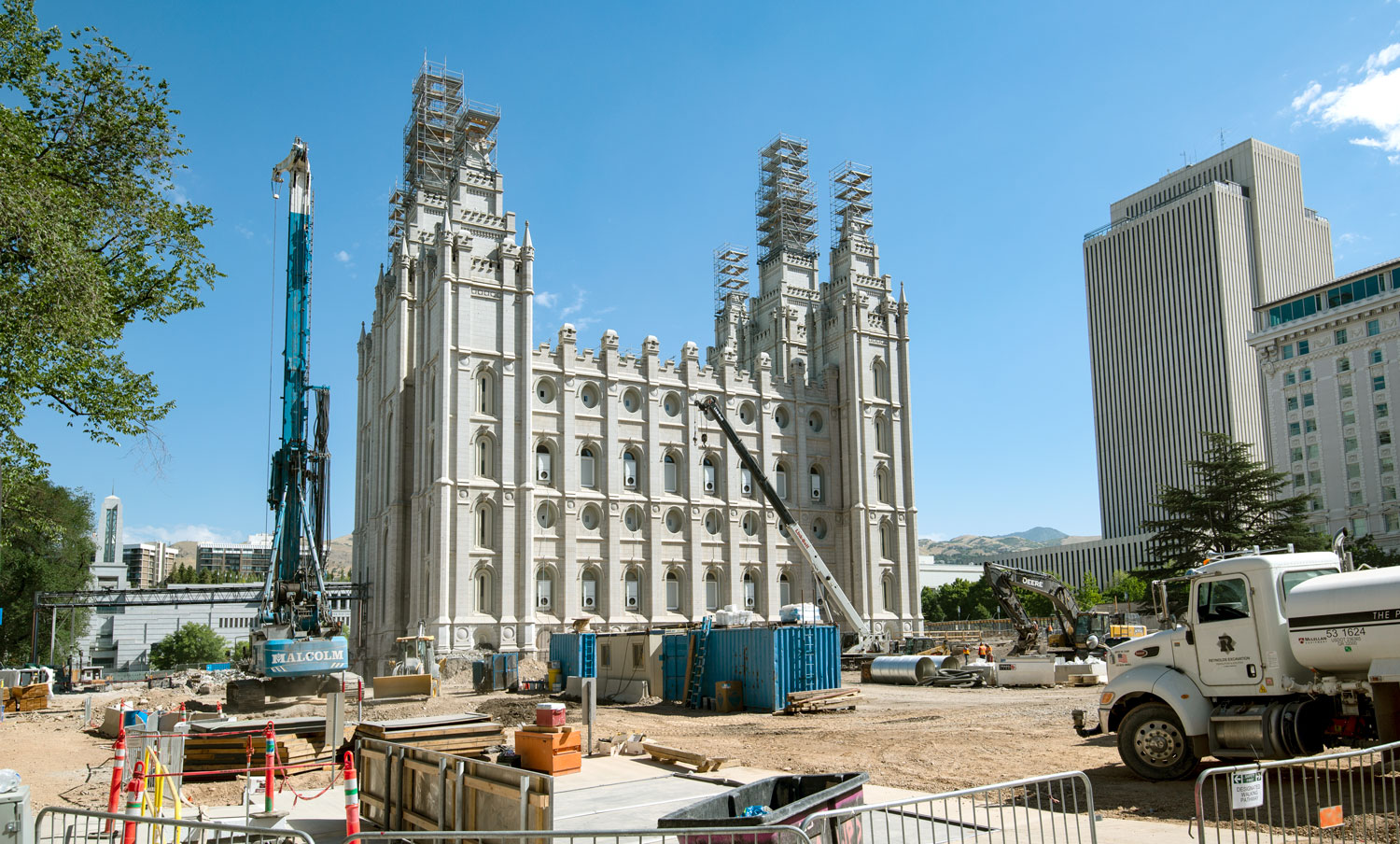Renovating a Western Landmark
Photos by Forrest Anderson; architectural renderings used by permission of the Church of Jesus Christ of Latter-day Saints
The normally bustling downtown heart of Salt Lake City, Utah, has been subdued this summer. The few pedestrians are wearing masks under a city mandate and the usually crowded historic sites and museums are closed.
In a state where tourism is a major industry that brings in $1.5 billion a year, Temple Square in the center of the city is normally by far the biggest draw. The historic square usually attracts 3 to 5 million visitors from all over the world annually, more than all of the state’s popular national parks combined. Normally, this landmark of the American West is a hive of tours (conducted in 40 languages), events and performances as well as a popular international destination wedding site where dozens of weddings are held every day except Sunday in the six-spired neo-Gothic Salt Lake Temple.
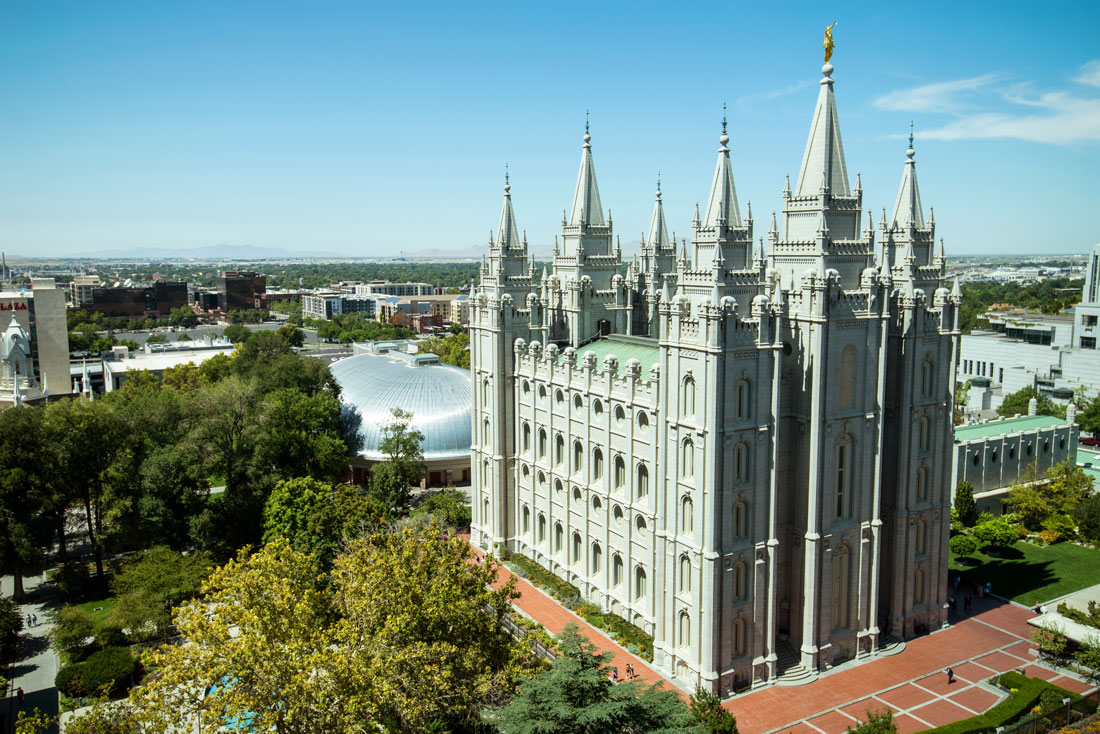
Temple Square and the spired temple before the renovation began in January.
The temple is the most well known symbol of both Salt Lake City and the Church of Jesus Christ of Latter-day Saints, for which the square and surrounding buildings are the world headquarters. The church operates at least 168 temples around the world, but many of its members still flock from all over the globe to be married in the Salt Lake Temple. Before the pandemic, the historic temple was in danger of being loved to death by throngs of wedding parties and other church members who crowded into its rooms for weddings and other religious ordinances.
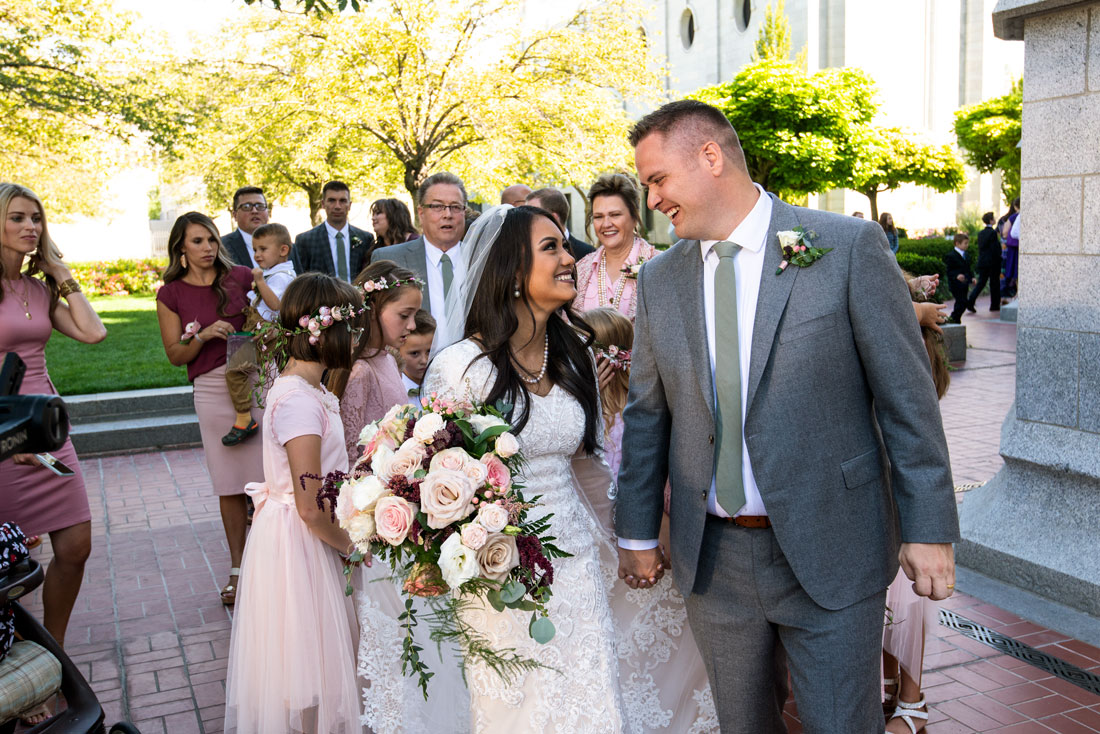
A bride and groom at the Salt Lake Temple.
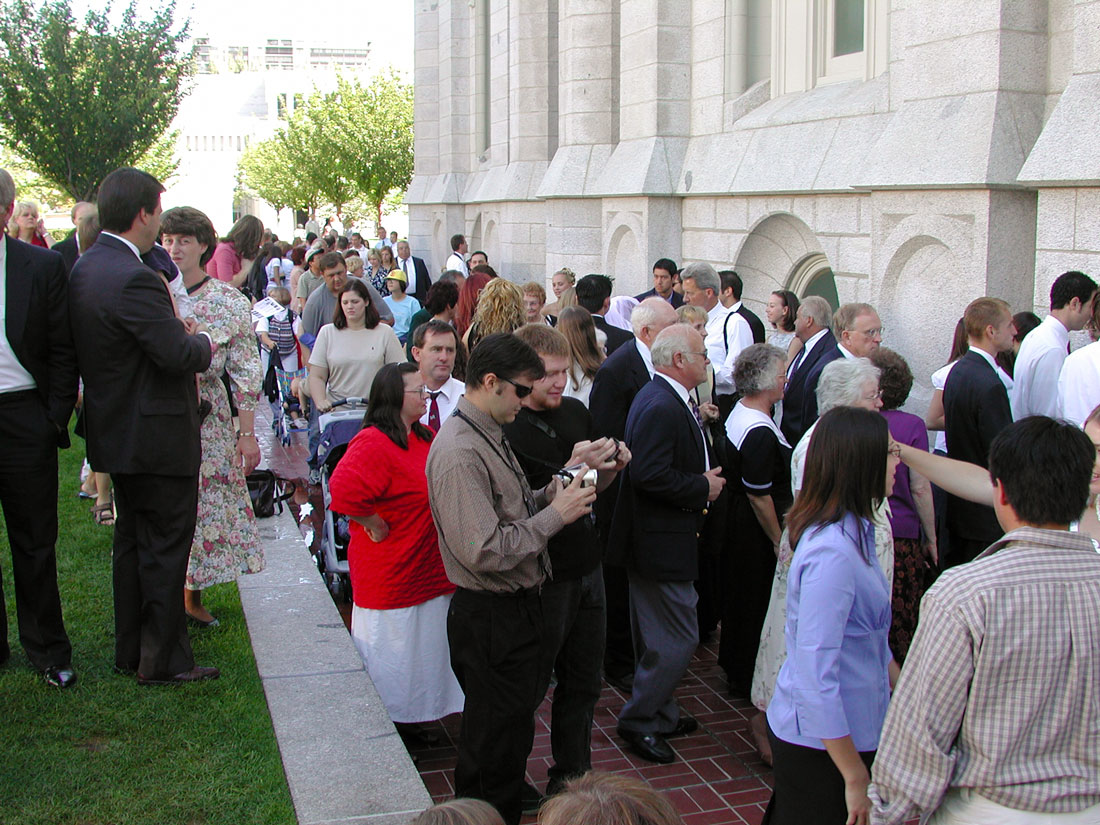
Members of wedding parties and tourists crowd a walk outside the Salt Lake Temple before the renovation.
Last year, the church announced that the building would be closed for four years for an extensive renovation of not just the temple but other parts of the square. Prospective brides and grooms, many with multi-generation family traditions of being married in the Salt Lake Temple, scrambled to book weddings there before the building closed in December.
Then the pandemic hit, along with a 5.7-magnitude earthquake that damaged the golden angel statue atop the temple and some of the spires. The church announced that all of its temples would temporarily close because of the pandemic (some have since reopened to small wedding parties and for some other ordinances on a limited basis depending on government pandemic regulations in different locales).
The square's historical buildings as well as nearby historical sites, museums, the church's Conference Center and Family History Library that is the world’s largest genealogical library were closed, the world-famous Tabernacle Choir on Temple Square canceled live performances and the usually packed square became a near-ghost town as construction crews in masks moved in to start the renovation.
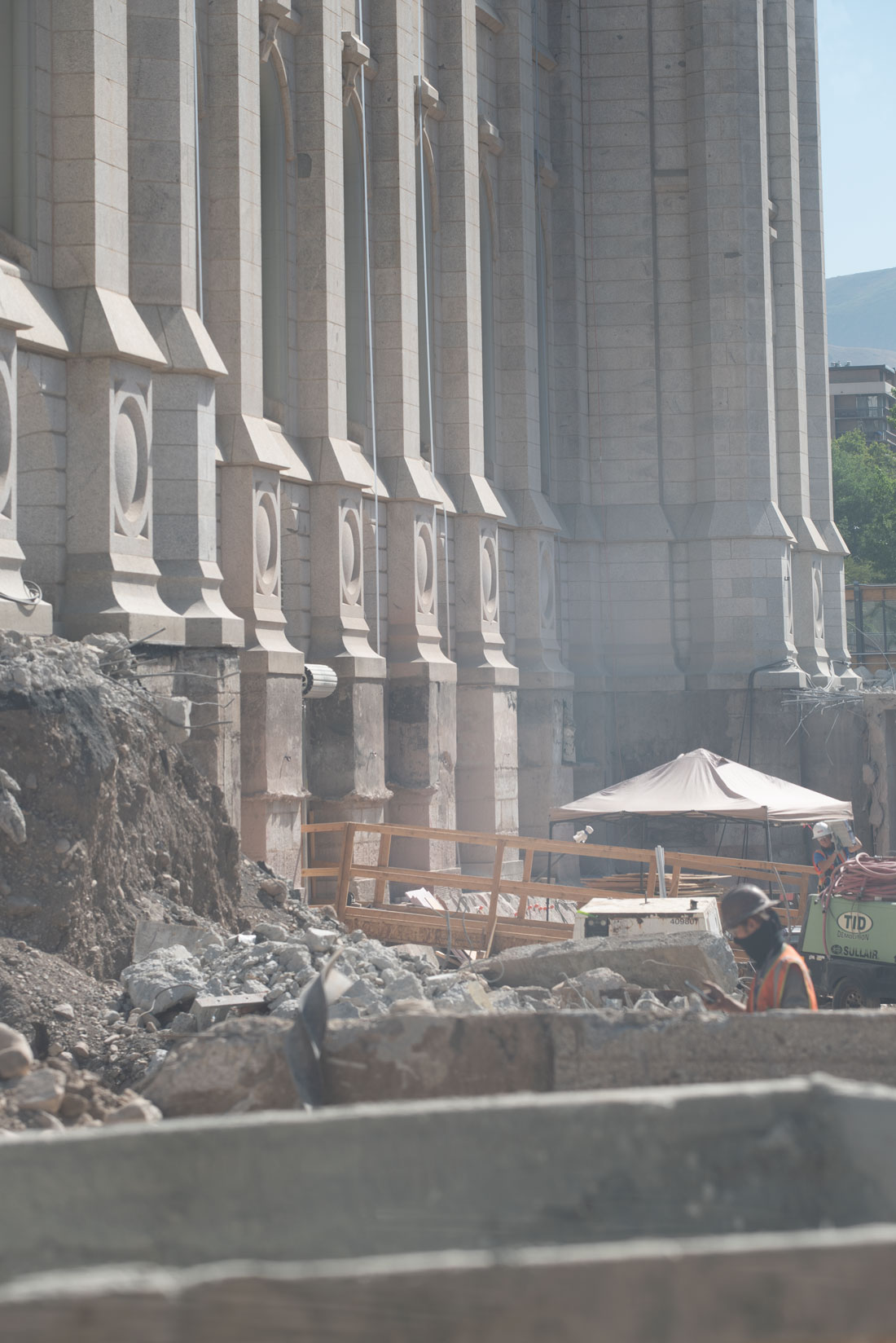
A masked construction worker makes his way through rubble and clouds of dust from demolition and excavation.
The temple and its square have immense religious and historical significance for Utah. The square marks the spot where Salt Lake City’s founder, religious colonizer Brigham Young, declared that the temple would be built as the city's center. The city's streets were laid out in all four directions from this spot and named according to their distance and direction from the temple.
In addition to the temple, the square is home to or within walking distance of many of Salt Lake City's and the Old West’s most famous landmarks. The famous oval tabernacle on the square, a 19th century pioneer building, is traditionally associated with the famous choir which broadcasts internationally from it on Sundays, although summer broadcasts are now at the church’s Conference Center north of the square to accommodate the large crowds of tourists who attend. The Tabernacle's organ contains 11,623 pipes, making it one of the largest and richest-sounding organs in the world, and the building has such sensitive acoustics that the drop of a pin at the front of the building can be heard throughout the building. Near the Tabernacle is the North Visitors’ Center, home to an 11-foot statue of Jesus Christ which is a replica of a statue by Danish sculptor Bertel Thorvaldsen. The statue is on the church’s official logo. Another pioneer-era building on the square, the Gothic-style Assembly Hall, normally hosts free weekly concerts.

The Joseph Smith Memorial Building, a beautifully restored 19th-century building once called the Hotel Utah, is a well-known dining venue with an elegant roof restaurant that has views of the square. Brigham Young’s houses - the Lion House which is another popular lunch spot and the Beehive House, now a historic house museum - are just east of Temple Square.
These buildings are closed to the public, along with the church’s world headquarters to the east of the square, because of the coronavirus. A reduced staff of volunteer missionaries in masks still work as guides on the west part of the square which remains open.

Missionaries at the square.
The renovation includes the demolition of several buildings on the temple’s north side and a visitors’ center on the south side to make way for new structures, removal and restoration of the temple’s tower finials, removal and restoration of the angel statue and the capstone it stands on, strengthening of the temple foundation and walls, dismantling of a variety of underground facilities, extensive updating of mechanical systems in the temple and restoration of the interior.
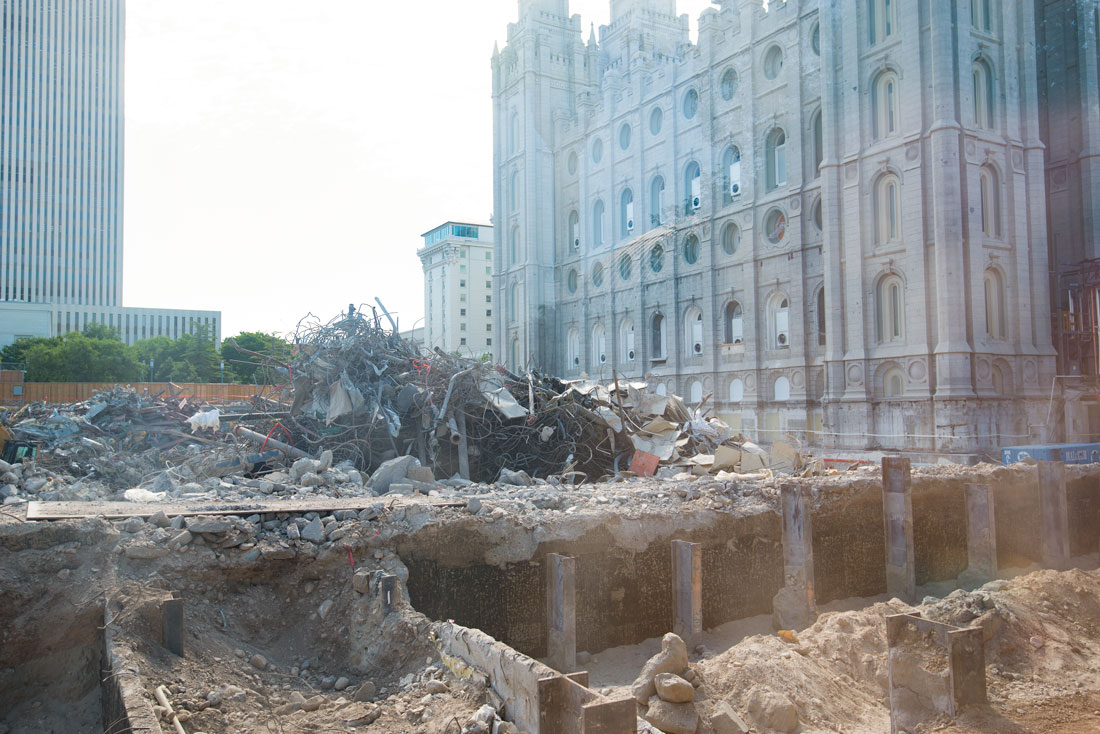
The normally pristine square has piles of rubble from the demolition of buildings and excavations around the temple itself.
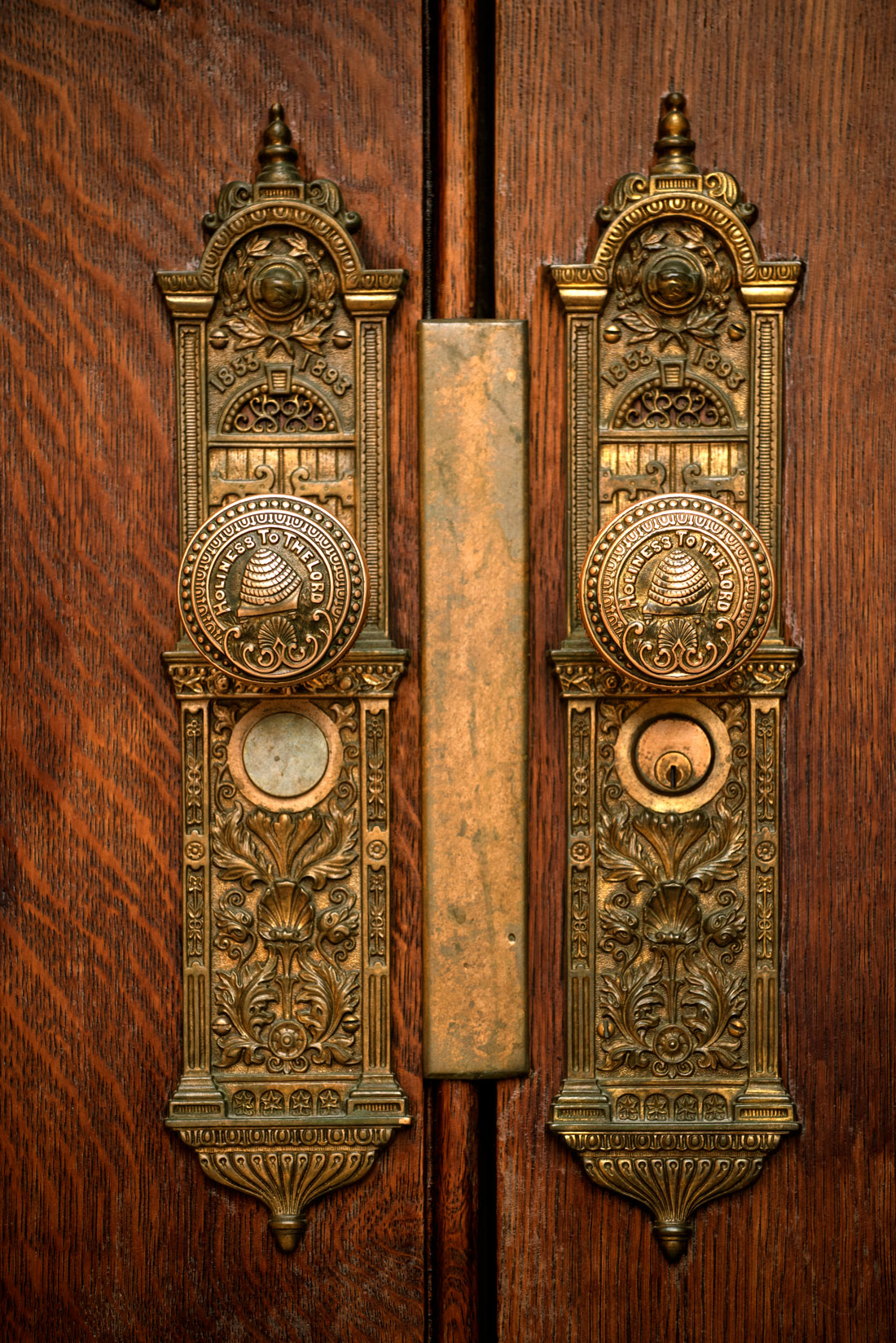
The Salt Lake Temple is a treasure trove of pioneer art down to the doorknobs (above). Doors, stained glass windows, furniture, light fixtures and other removeable artwork have been taken out, and woodwork and other features that can't be removed have been shrouded to protect them during the renovation. Special air conditioning units have been installed to control the temperature and humidity inside the building and protect the woodwork and finishing.
The spire finials were removed and scaffolding has been placed around what remains in place of the spires to stabilize them during the construction.

Statues and trees were removed from around the building except for some well-known trees which construction crews are working around so they can be preserved.

The building's ornate doors have been removed.
Steel columns are being used to shore up retaining walls for the deep excavation that will expose the pioneer-era foundation on the north side. The foundation is being excavated to install huge seismic stabilization discs under the stone structure. The disks, called a base isolation system, are designed to absorb earthquake shock waves. Workers will place the disks at intervals between the ground and the temple’s footings and foundation. The disks will become the temple’s actual foundation and when the earth moves, they will absorb the shock like shock absorbers on cars. The walls and towers also will be strengthened against earthquakes, which are a concern because Utah is prone to earthquakes.
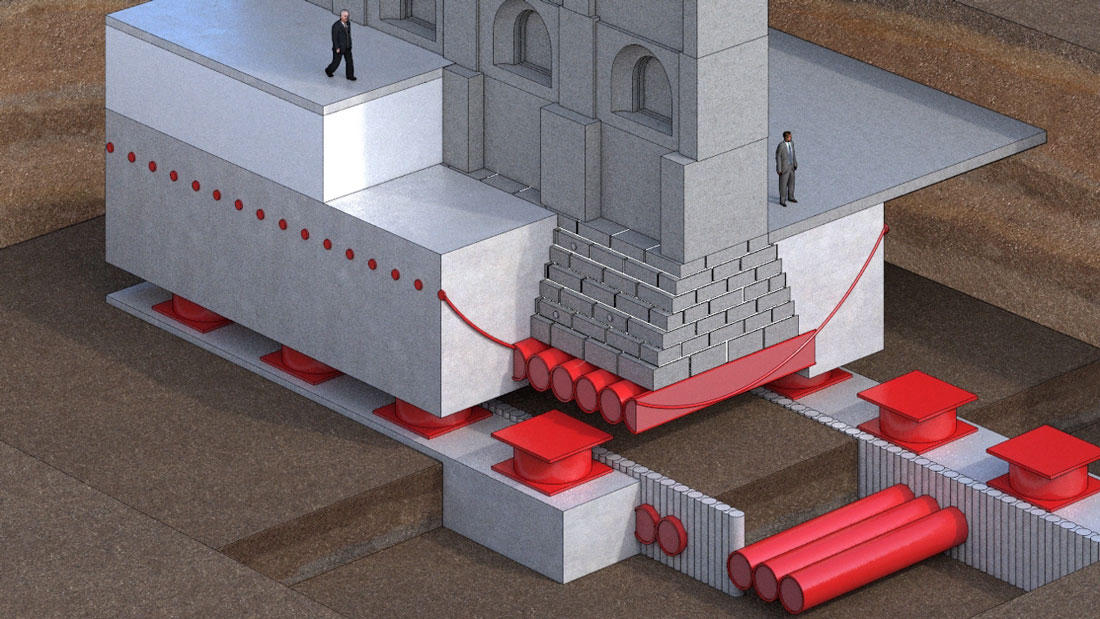
This rendering shows the base isolation system to be placed under the temple to enable it to withstand 7.2-magnitude earthquakes. Below, the walls also will be strengthened against earthquakes.
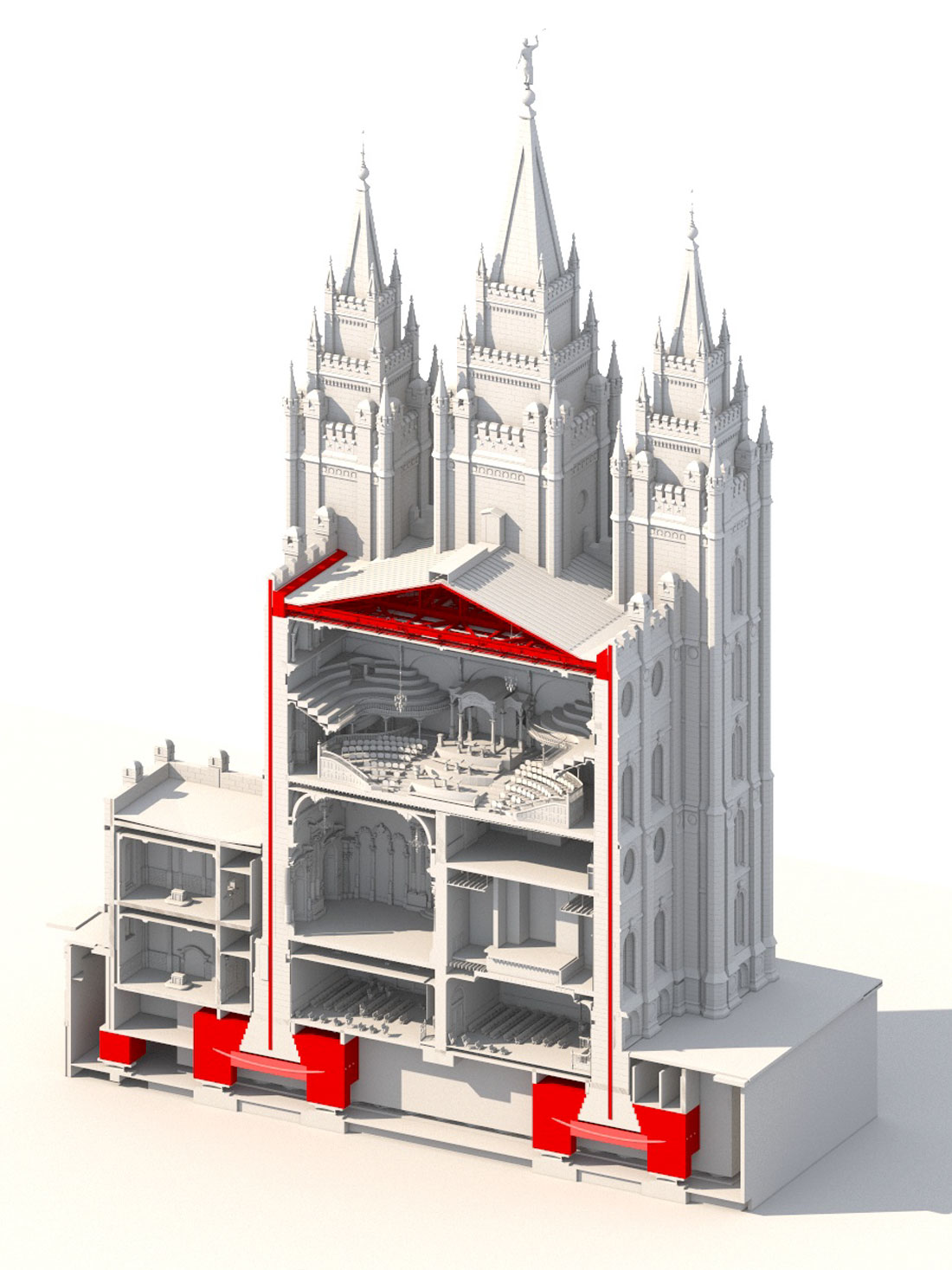
Obsolete mechanical, electrical and plumbing systems in the building will be updated and access for people with limited mobility will be enhanced. Part of the reason for the renovation is to provide facilities that will enable the temple to better serve church members from around the world in 86 languages.
Buildings that have been demolished will be replaced with new guest and visitor pavilions. Church members will enter through the pavilions or through a tunnel from a parking lot to the north and go down to a grand underground hall with large skylights that provides views of the temple above.
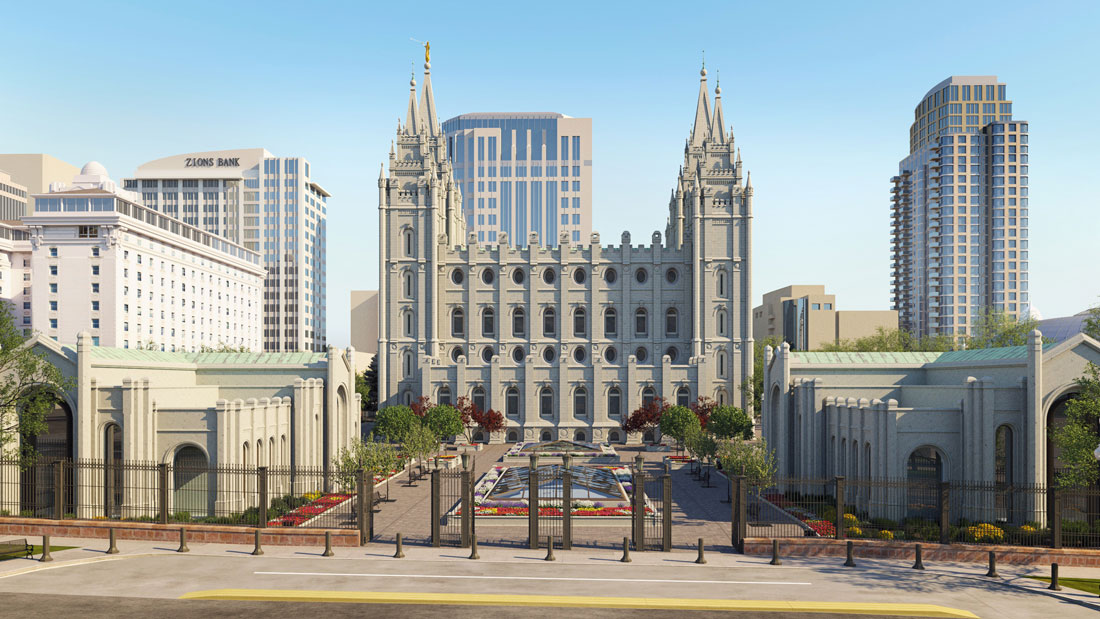
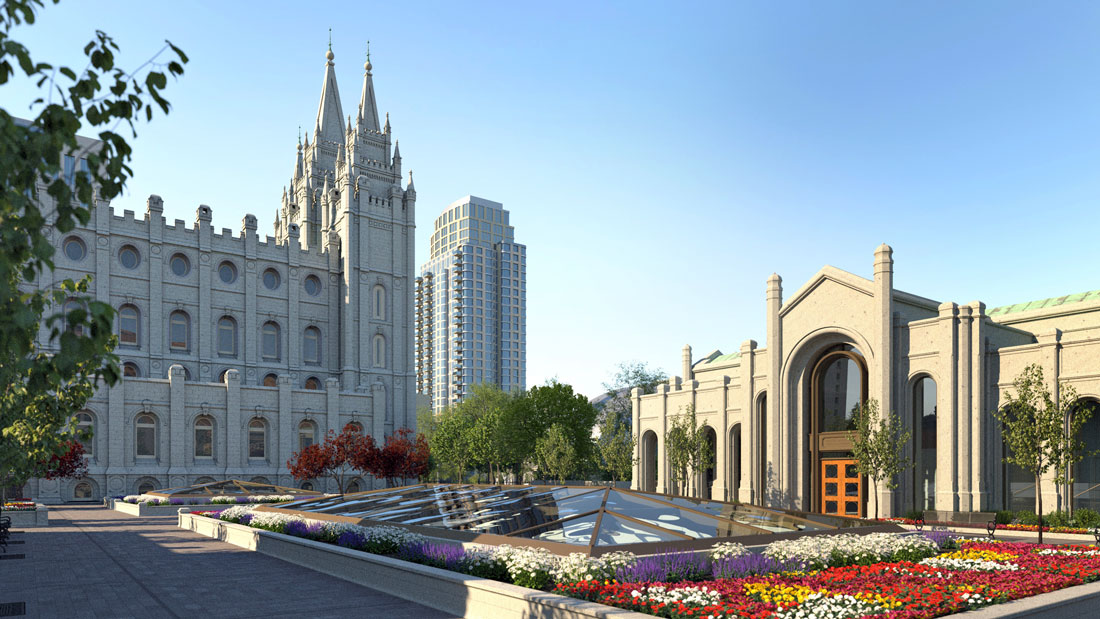
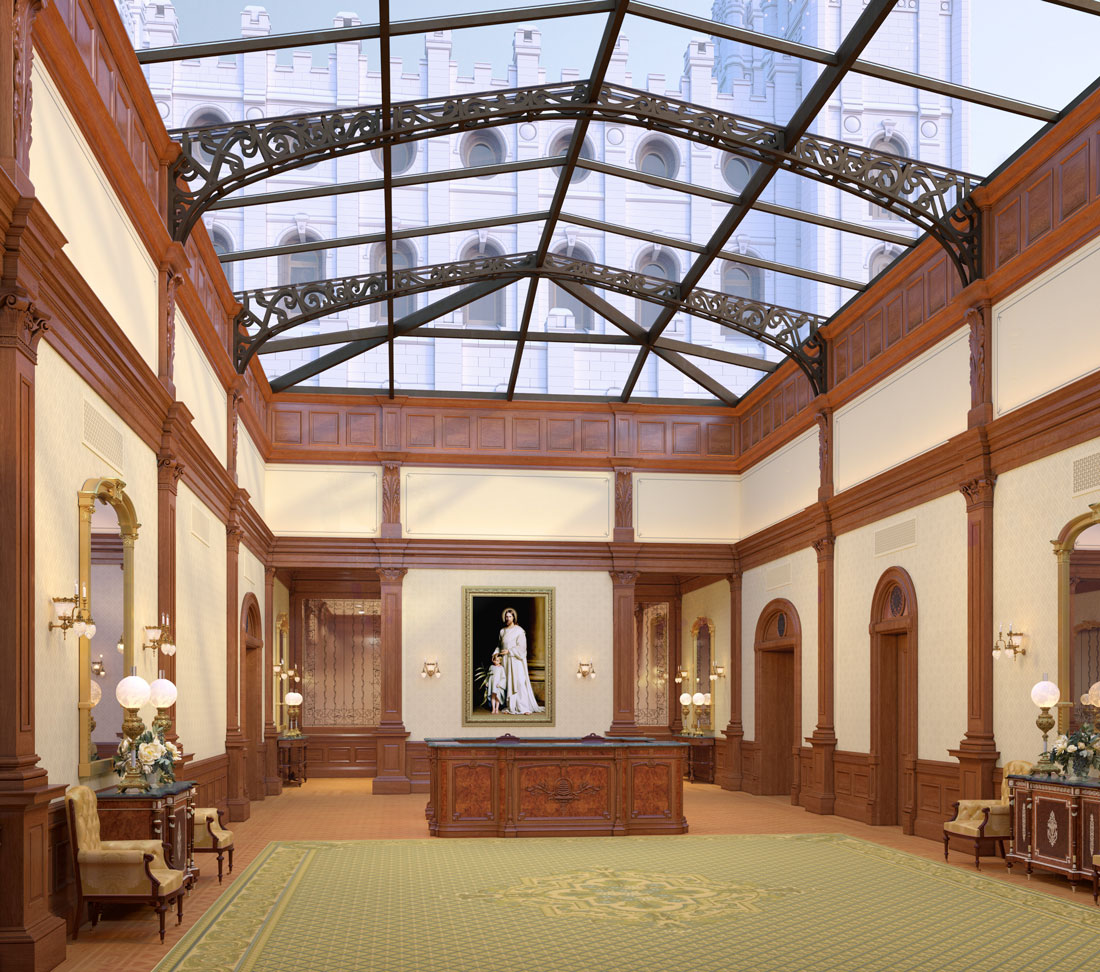
Brigham Young chose the location of the Salt Lake Temple in 1847, just a few days after the first Mormon pioneers entered the desert Great Salt Lake Valley in covered wagons. After planting crops and building homes, the settlers began the temple’s construction in 1853. The temple took 40 years to build, partly because construction on it halted as a federal army entered the valley in the 1850s amid a federal government dispute with Young. Young had the foundation covered over to avoid the army vandalizing it. When it was later uncovered, it was discovered that some of the sandstone foundation stones had cracked. They had to be replaced before construction could resume on the temple, which finally was dedicated on April 6, 1893.
The temple owes its Gothic-Romanesque elements to architect Truman O. Angell, who Brigham Young sent to Europe to study cathedrals and other sacred architecture to build the temple. The castle-like walls of the building were made from quartz monzonite from Little Cottonwood Canyon 20 miles to the southeast. Oxen initially pulled the stone-loaded wagons to the temple site until a railroad was built to carry them at a faster rate.
Since then, the building has gone through a number of renovations, with the most recent extensive one being in 1962-66. The church’s temples are heavily used and regularly renovated, usually to reflect the era in which they were built while upgrading their functions.
Renderings of the Salt Lake Temple renovation indicate that its late 19th-century architecture will be largely preserved. Inside, some work done during previous renovations will be removed to better reflect the character of the building at the time it was built. This includes restoring woodwork, which was painted white in the 1960s, to its original dark wood appearance. Original colors will be used along with a carpet pattern that is a replica of a carpet used in part of the original interior. Wall murals will be cleaned and brightened. The temple baptistry had been downsized to accommodate 1960s heating and cooling systems, but will be restored to its original spaciousness because updated mechanical systems will be more compact.
These renderings of the way the interior is to be restored were released by the church for press use:

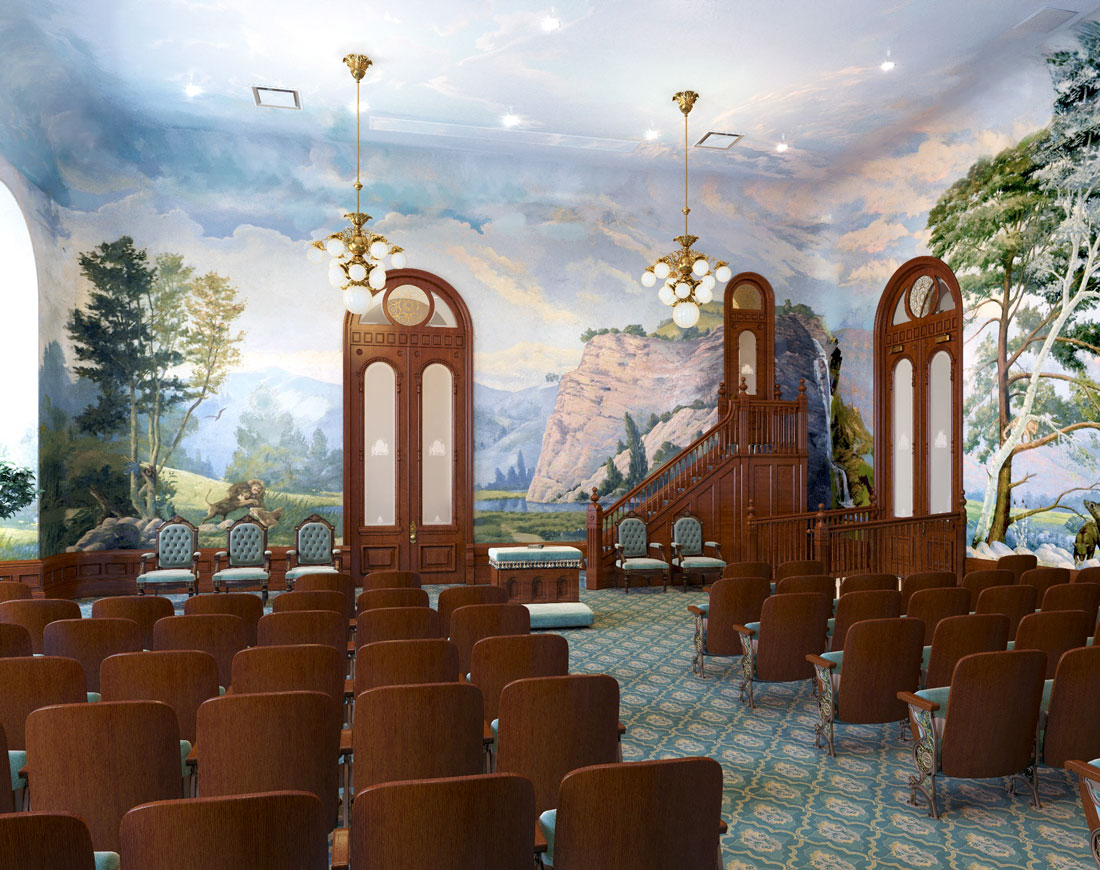
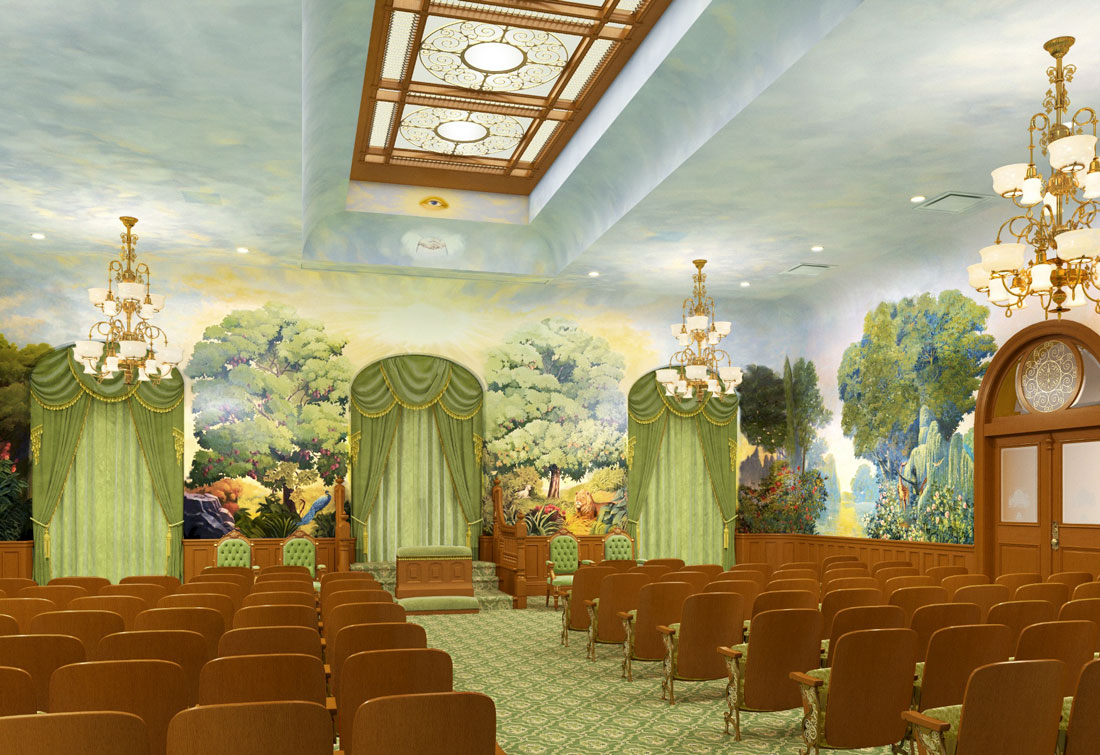
The plaza in front of the church’s world headquarters to the east of the square also will be renovated starting in late 2020.
Temples are considered the most sacred space in the faith’s worship. Because they are staffed by volunteers and the church has a lay clergy, members are not charged for weddings and other ordinances in the temple. Temple attendance is not a requirement for church membership, but those who do enter the temples commit to live morally clean, honest lives, abstain from alcohol, tobacco, tea and coffee and pay regular tithes to the church.
The temples are known for the stringent construction standards the church insists on. The church has developed an international reputation for historical preservation and restoration expertise because of its restoration work on its temples and other historic structures that it owns and maintains. The church also has hired a variety of experts in preserving historic stone, murals, plaster, wood and metal to work on aspects of the Salt Lake Temple restoration.
As part of the project, a time capsule with materials that originally were placed inside the temple’s capstone upon which its golden angel stood has been opened. The items were placed in the time capsule on April 6, 1892, along with at least 400 coins that onlookers threw into the capstone. The capstone was then placed in position in a ceremony signifying the end of construction on the temple. The capstone was removed and opened in May this year. It turned out to be two halves that were entirely filled with cement. In the cement were four packets of materials, including several religious books, letters, a gold-leafed copper plate inscribed with the words “Holiness to the Lord,” and the names of the church’s main leaders at the time of the 1853 groundbreaking and in 1892. There also was a paper envelope with seven mounted photographs, called cabinet cards. The items in the time capsule were damaged, and the photographs no longer had discernable images, but bore the inscription of well-known Utah photographer C.R. Savage. A pencil, rope, metal bit, and paper scrolled around a wooden dowel also were found. Fifteen of the coins were inscribed with names of some local families. All of the materials were damp because concrete lets off water and heat as it cures. The water and heat caused the materials to deteriorate badly. The capstone items are expected to be placed on public display at some point.
The temple had two time capsules. The other one, placed in the foundation, was excavated in 1993 during another restoration. It contained several publications.
The Salt Lake Temple has an administrative function that the church’s other temples don’t have, as senior church leaders meet there usually on a weekly basis. While the building is being renovated, they will meet in the Joseph Smith Memorial Building to the east.
Unlike the church’s local chapels, where Sunday worship services are held, the temples are used for sacred ordinances such as marriages and proxy baptisms for deceased ancestors, which are part of the church’s doctrine. There are at least five other temples in the Salt Lake City area, which are open on only a limited basis by appointment because of the pandemic.
Temple Square is one of the world’s well-known gardens, known for the tulips that adorn it in the spring and Christmas lights that shimmer by the thousands on its trees at Christmas time. Choirs, orchestras, bands and huge crowds usually gather, different performances are scheduled daily, and the lighting display is different every year. These traditions are to continue in the long term, although they may be interrupted this year by the pandemic.
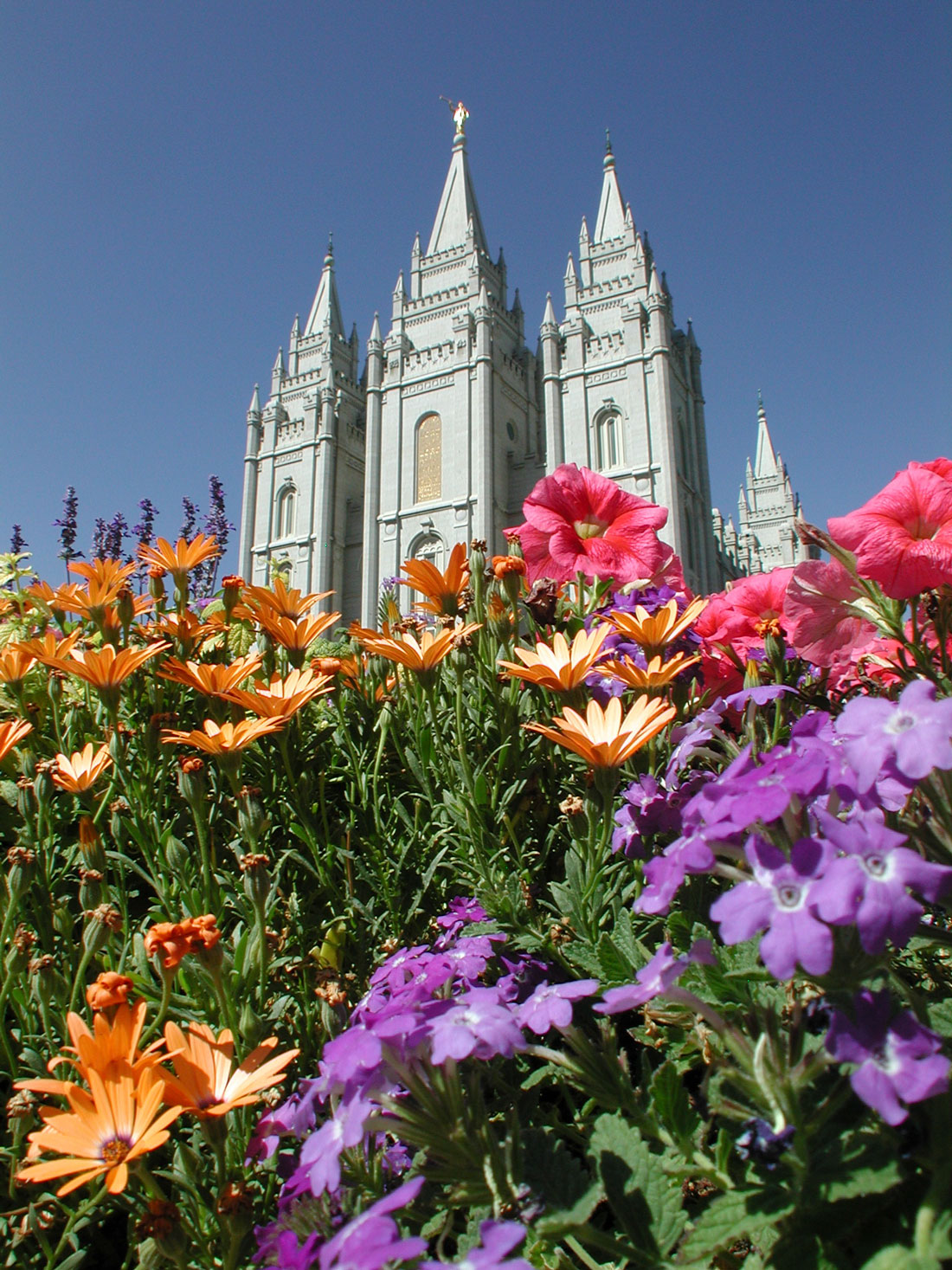
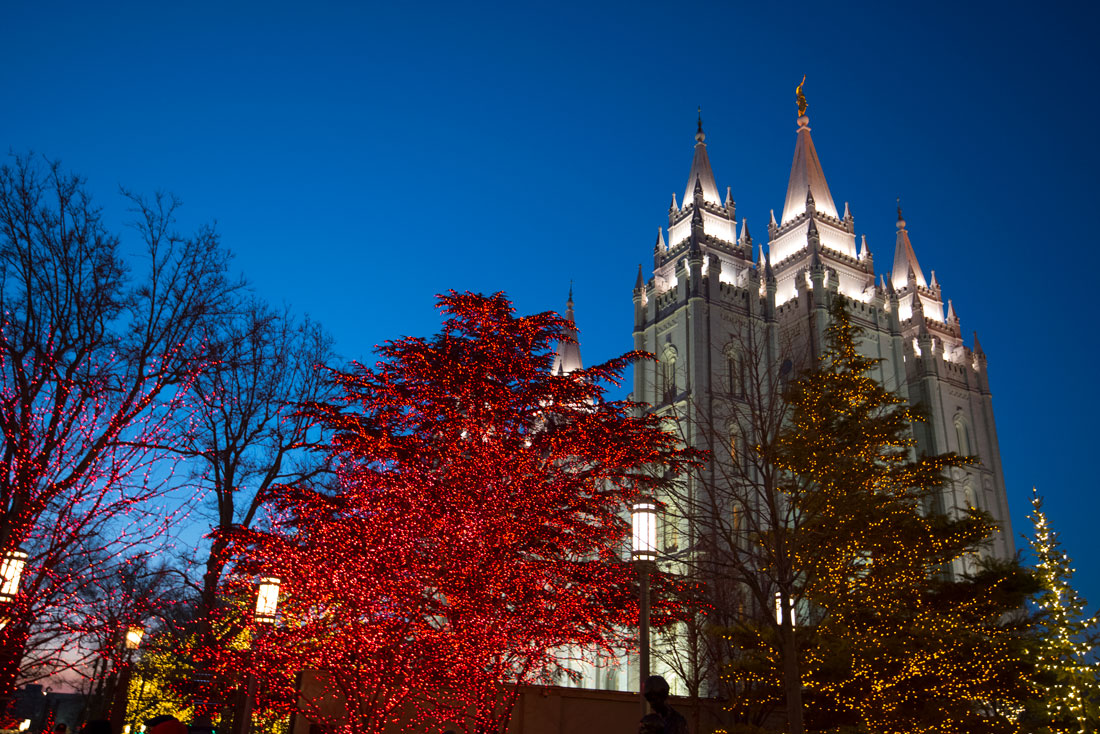
Some 500 people will work on the renovation project at its height, and a total of thousands of workers will be involved. The church plans to use as much of the demolished material as possible in the reconstruction.
The temple will reopen in 2024 with an open house for the public, the first time that it has been open to the public since it was first completed in 1893.
Along with the Salt Lake Temple, other pioneer-era temples in Utah are being renovated in St. George, Manti and Logan. Renovation work has begun on the historic St. George Temple in southern Utah. This building, the longest operating temple of the church, was built by pioneers in 1877. It was the first completed in Utah.
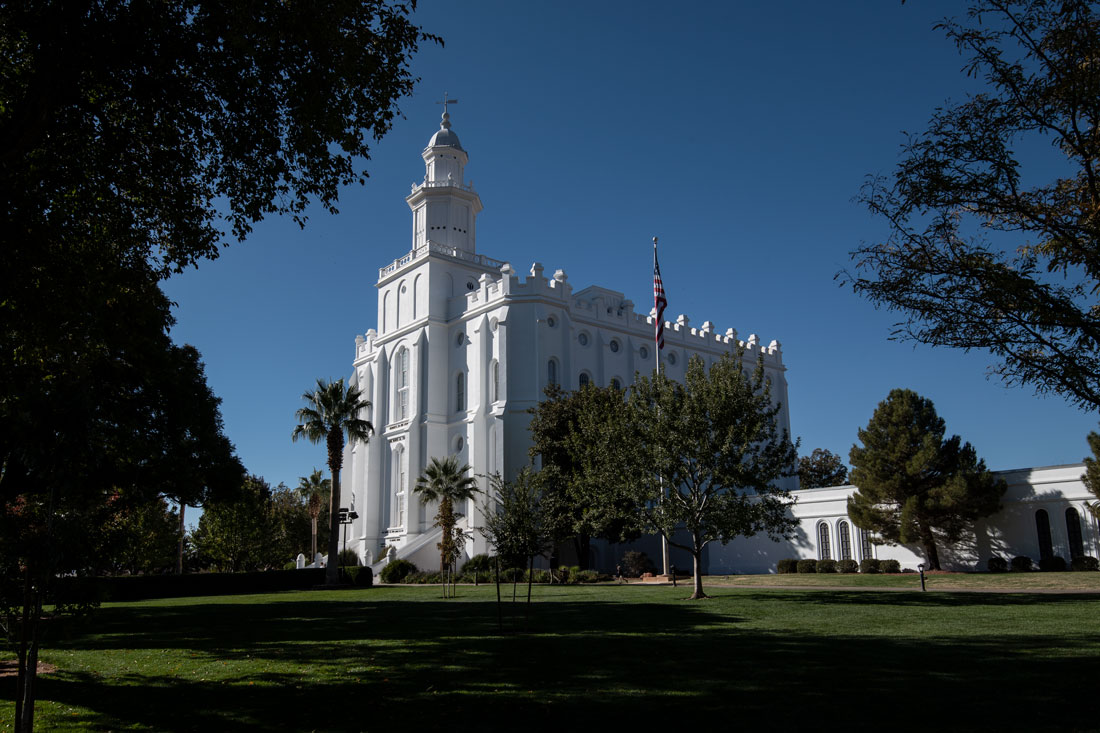
In recent years, it has been inadequate for the crowds that wanted to use it. The structure will be renovated and mechanical, electrical and plumbing systems will be updated. Additions that had been added to the building in previous renovations have been removed, revealing original door openings, windows, floor plan and paint colors. The new project will include moving support services such as a cafeteria and mechanical systems into a new annex and out of the temple.
A team of historians has done extensive research on the building and the information has been used to create a design that preserves the building's history while dealing with modern demands on the building and building codes.
The temple interior will be updated with windows and columns that match those on the original structure. It will be furnished in the style that pioneer settlers in St. George when it was constructed would have been familiar with. The building originally had murals, which were removed during one of the prior renovations. New murals that mimic what the temple looked like before that renovation will be installed in some rooms. This restoration is scheduled to be completed in 2022. The St. George Temple also will be rededicated after a public open house.
Two other landmark temples, the Oakland California Temple and the Washington D.C. Temple, were recently renovated to upgrade their mechanical systems, finishes and furnishings. The Oakland Temple is on a hill overlooking Oakland, Berkeley, San Francisco and the Bay, and the Washington temple is a prominent landmark that is visible from the Capital Beltway.
Check out these related items
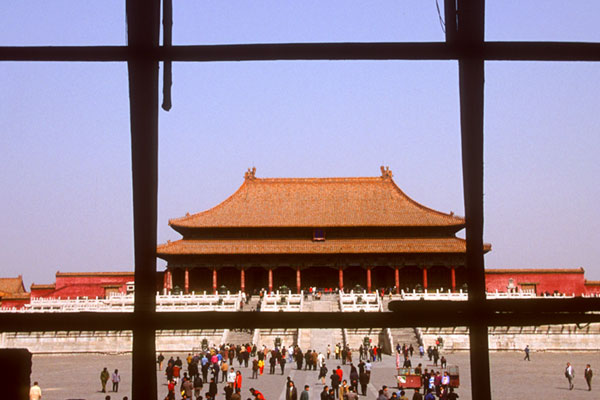
Scaffolding the World
Finding a historical site shrouded in scaffolding is disappointing, but it is a valuable tool for preserving the world's heritage.
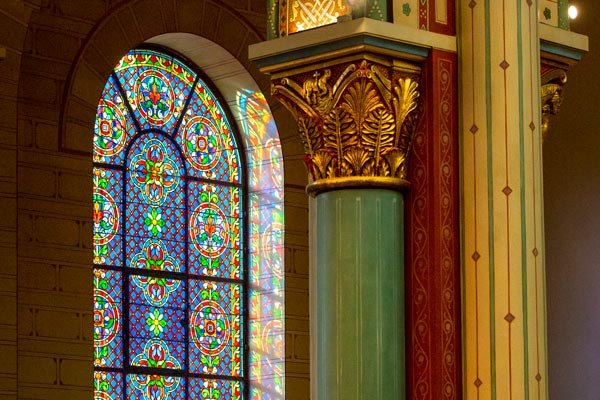
Paris’s Oldest Church Restored
Paris' oldest church, Saint Germain des Prés, is emerging from layers of grime and soot as a meticulous restoration reveals its vibrant color.
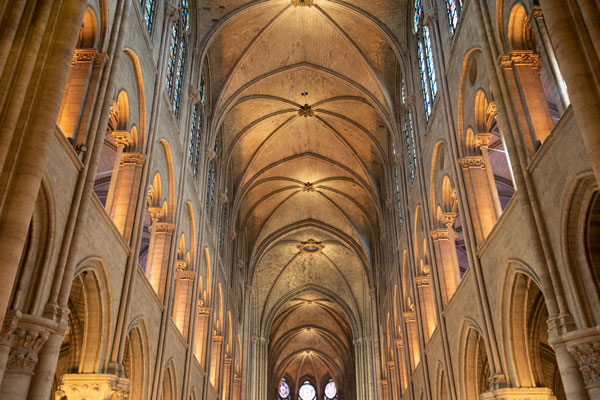
The World Mourns Notre Dame
Notre Dame Cathedral of Paris, France's national cathedral, was badly damaged in a fire.
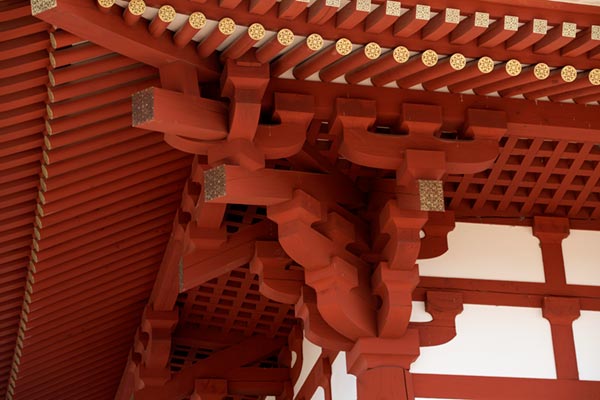
A Palace to Remember
Visible traces of the Heijō Palace, Japan's palace from which the emperor ruled in splendor, were gone, until the site was restored.

How is Utah Changing?
The Utah population boom, fueled by economic growth and an image of a healthy, family-friendly state, is expected to be long-term.
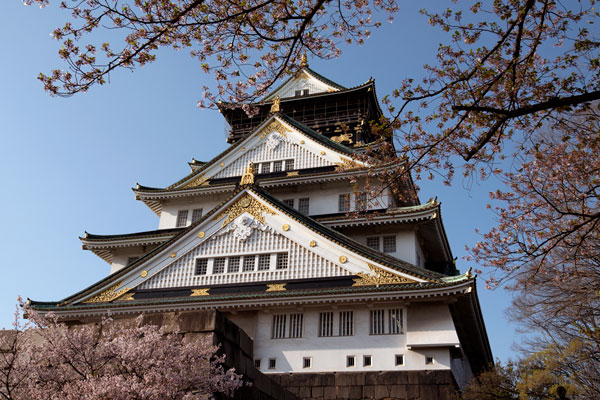
Battle of the Samurai
Osaka Castle marks the site of an epic samurai battle and one of the most important turning points in Japanese history.
